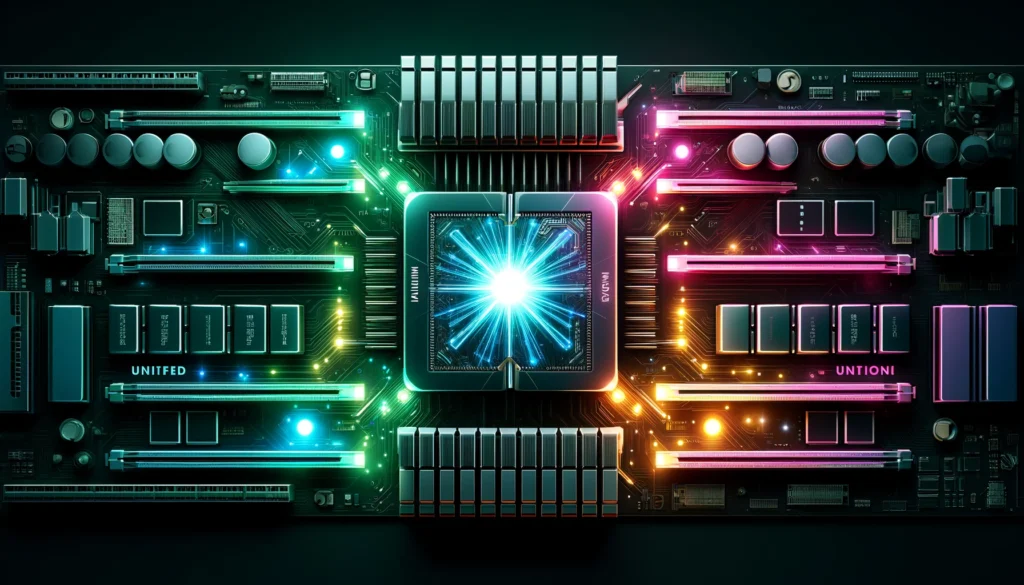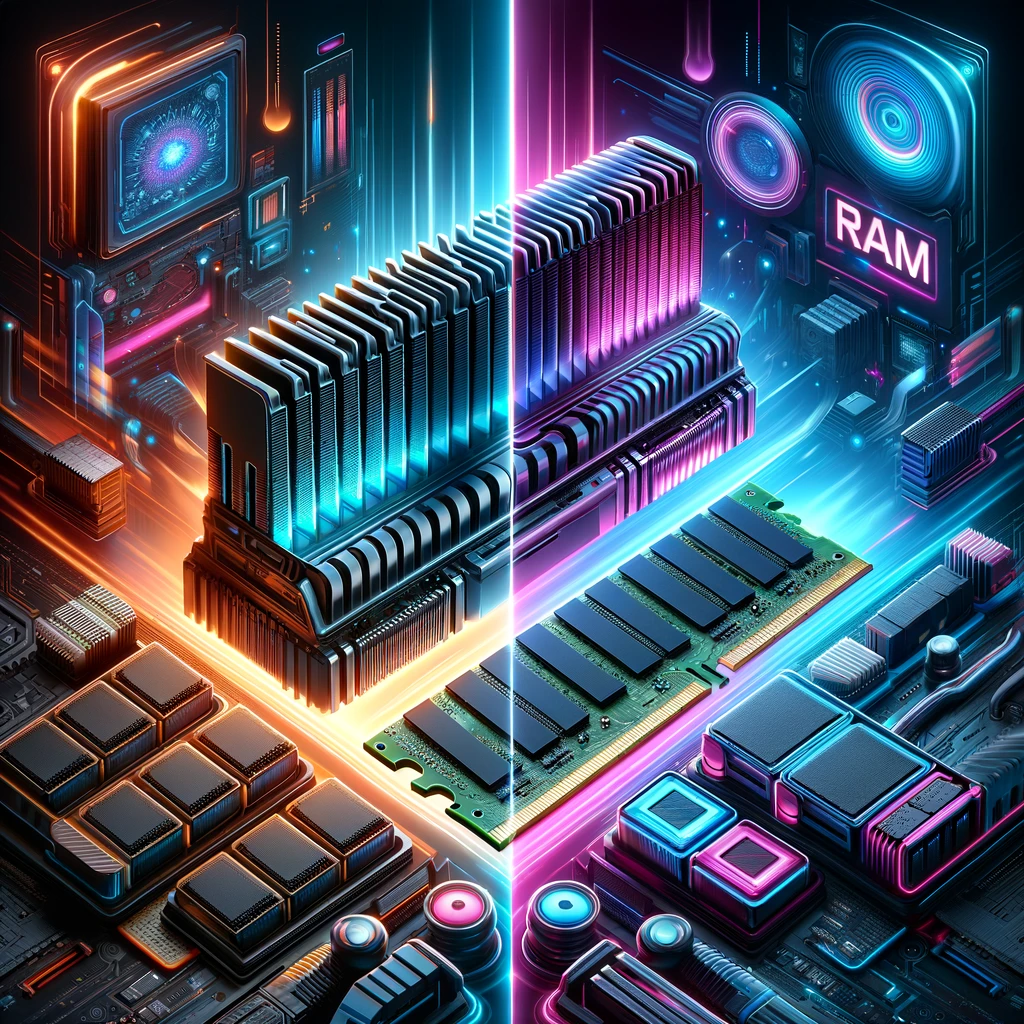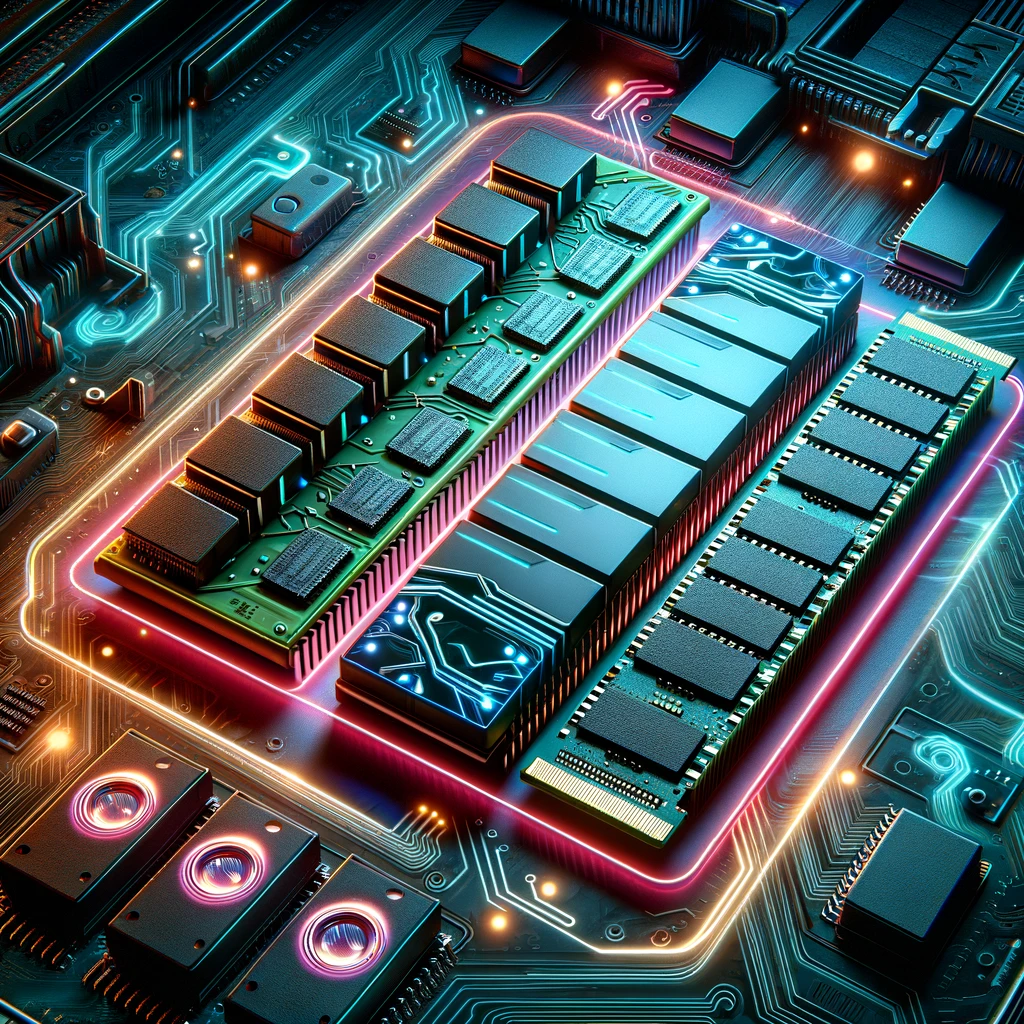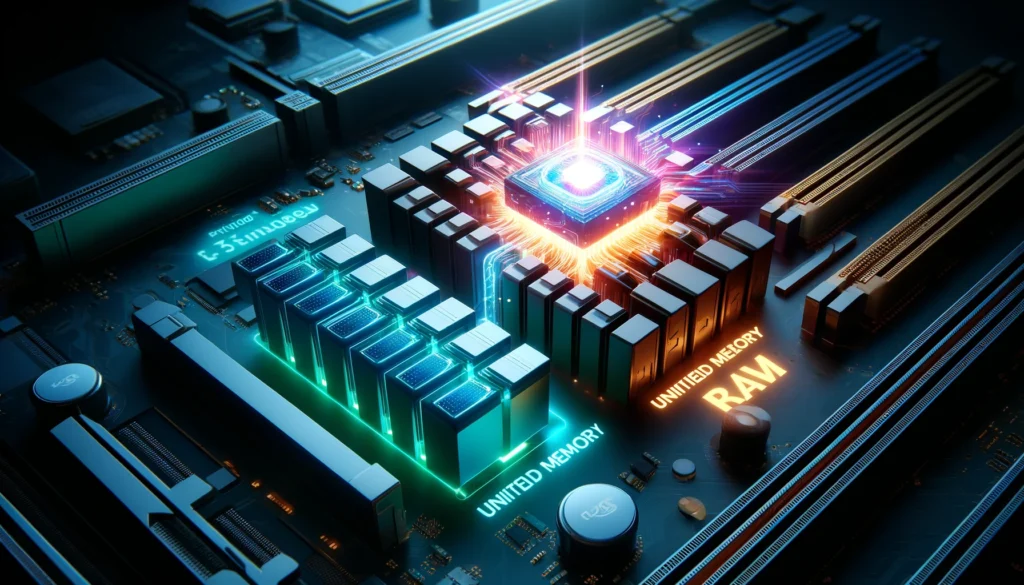Are you struggling to decide between Unified Memory and traditional RAM for your Mac? This comprehensive guide elucidates the differences between these two forms of computer memory, focusing particularly on Apple Silicon Macs.
You’ll uncover how Unified Memory functions, its advantages over conventional RAM, and considerations for choosing between 8GB and 16GB options. We’ll also delve into why integrating the central and graphics processing units with Unified Memory in M1 Macs marks a significant shift in performance optimization.
By reading this Blog, you will gain the insights needed to decide on the best memory configuration for your Mac, Like Unified Memory vs RAM, resolving any confusion and setting you up for a smoother computing experience.
Understanding Unified Memory in Macs

As a Mac user, I’ve observed a shift towards integrated hardware, with Unified Memory at the core of the latest MacBook Pro enhancements. Unlike conventional RAM, Unified Memory streamlines data accessibility and optimizes performance.
This innovative architecture marries efficiency with power, a contrast I’ll dive into by explaining how 8GB Unified Memory stacks up against traditional RAM. The successive sections will dissect the benefits of this advancement, which is crucial for those wielding a MacBook or a MacBook Pro.
What Is Unified Memory?

In my experience with Macs, I have come to appreciate the efficiency of Unified Memory, a form of integrated circuit that amalgamates computer data storage within a single system.
Unlike the traditional separation of RAM and storage, where a device might house multi-gigabyte RAM alongside a hard disk drive or flash memory, Unified Memory allows the CPU and GPU to access the same data pool without copying multiple memory spaces, enhancing performance and energy efficiency.
As I see it, this architecture fundamentally alters how tasks are managed on a MacBook, particularly when handling large files or multitasking. No longer is the processor bogged down by the need to shuttle data between separate storage entities. Instead, the bridged structure of Unified Memory ensures swifter data retrieval, akin to having your most-used tools within arm’s reach.
This means that whether you’re editing 4K video or running several demanding apps simultaneously, your Mac‘s Unified Memory provides a seamless experience without the lag traditionally associated with a standard gigabyte RAM system.
How Unified Memory Differs From Traditional RAM
In using various Mac systems, I’ve observed that Unified Memory is not just another type of RAM; it’s a different approach to processing data. While traditional RAM is about having a certain amount of fast-access storage, Unified Memory in systems like the MacBook Air involves a shared pool between the CPU and GPU.
This integration allows for heightened bandwidth, ensuring both processors can execute tasks more swiftly and efficiently than with segregated RAM, making the laptop‘s operating system run smoother during high-demand applications.
From my experience with the latest MacBook models, Unified Memory vs. traditional RAM’s advantage becomes quite clear when running memory-intensive tasks. Rather than waiting for data to transfer over a bus from one type of storage to another, Unified Memory allows the CPU and GPU immediate access to the same memory pool.
This architecture streamlines operations, reduces latency, and ensures that my MacBook‘s performance stays responsive, even under a heavy load, without duplicating data— a significant leap forward in computing efficiency that Mac users can benefit from.
Advantages of Unified Memory Architecture
One of the core advantages of Unified Memory Architecture in products like the Mac Mini is the harmonious coordination between the GPU and the CPU, which increases the density and efficiency of data storage and recovery operations.
When I run several complex applications on my Mac, the fluid interplay between the processing units under Unified Memory means that my personal computer maintains a high level of performance without the constant shuffling of data between separate pools, which can often be a bottleneck with traditional RAM setups.
The benefits here are not just theoretical; in practical terms, when I work with resources that require heavy data recovery, such as complex video editing or large-scale image processing, the responsive and efficient data access provided by Unified Memory ensures that memory management issues do not disrupt my workflow. Consider this table comparing key aspects of Unified Memory and traditional RAM:
| Feature | Unified Memory | Traditional RAM |
|---|---|---|
| Data Accessibility | Direct shared access by CPU and GPU | Separate access, often causing data redundancy |
| Performance Efficiency | High due to shared pool | Variable, depends on data transfer speeds between components |
| Energy Consumption | Optimized for lower consumption | Higher due to data transfer overhead |
| Data Recovery Speed | Faster due to immediate availability | Slower due to separate storage locations |
Fig No 1
This improved resource management on my Mac translates to a snappier computing experience and contributes to energy savings. Since the machine operates more efficiently with Unified Memory, the battery life of my MacBook Pro is noticeably extended, making it an ideal feature for professionals on the go or anyone who requires dependability and performance from their personal computers.
Traditional RAM Explained

In examining traditional RAM, we must understand its foundational role in computing, where it serves as crucial computer hardware for temporary data storage, enabling quick access to computer files and smooth workflow operation. Despite this, the limitations inherent in separate memory systems, such as diminished efficiency and increased consumption, contrast significantly with Unified Memory. This memory‘s role in compatibility with older Mac models is also noteworthy, as systems on a chip and firmware advancements push hardware design forward. As we discuss these contrasts, I’ll aim to offer insights into how each aspect affects Mac performance.
Functions of RAM in Computing
Within my extensive use of computers, I’ve noted how Random Access Memory, or RAM, functions as a computer‘s short-term memory, which is indispensably tied to its performance. This storage area is critical for temporarily holding data that the system‘s silicon brains – the CPU and sometimes integrated graphics – need to access quickly. Without ample RAM, tasks become sluggish because the technology relies on this component to store and retrieve data efficiently, ensuring that applications run smoothly and the user experience remains seamless.
Having worked with various computer setups, I can attest to the pivotal role of RAM when dealing with memory-intensive processes, such as editing high-resolution images or playing graphics-rich games. The technological backstage allows the data needed immediately by the Intel CPU and the graphics unit to be at the forefront, ready for swift action. When RAM is lacking, even the most powerful silicon technology can’t compensate, leading to a bottleneck effect where the potential of the computer can’t be fully realized due to insufficient immediate data access.
Limitations of Separate Memory Systems
In my experience with a range of computing equipment, including Apple’s iMac with Intel processors, the separation of CPU and GPU memory can lead to inefficiencies, particularly in systems not equipped with the Apple M1 or M2 chip. This separation can result in higher latency since the CPU and GPU must communicate through an often crowded ‘digital Ethernet,’ slowing down the response time in demanding tasks like server management or complex graphic rendering.
Furthermore, I’ve observed that when separate memory systems are used, the parallel operation of CPU and GPU-intensive tasks is hindered, limiting the full potential of Apple’s hardware. Memory coordination in this traditional setup requires meticulous management to prevent bottlenecks. This challenge becomes especially prominent when transitioning from tasks requiring substantial CPU resources to GPU-centric tasks.
| System Component | Separate Memory System | Unified Memory System |
|---|---|---|
| CPU and GPU Coordination | Lower efficiency due to separate memory pools | Increased efficiency with shared memory resources |
| Response Time for Tasks | Slower due to inter-bus communication latency | Quicker, as CPU and GPU can access data concurrently |
| Resource Management | Complex, with possible bottlenecks | Simplified, with smoother transitions between tasks |
Compatibility With Older Mac Models
My experience with older Mac models shows that traditional RAM plays a significant role in upholding system compatibility with the MacOS architecture. These models, predating the innovation of Unified Memory, are designed around the concept of discrete disk storage and separate memory for the CPU and GPU, often showing their age during resource-intensive tasks such as video editing or simply managing numerous tabs in a web browser.
While the architecture of older Macs doesn’t provide the seamless engagement of Unified Memory, practical workarounds exist to optimize performance. For example, when I use a legacy Mac, increasing the RAM often mitigates slowdowns, sustaining a smoother operation of MacOS and applications that heavily rely on memory, such as creative software suites and browsers.
Unified Memory vs RAM: Key Differences

Distinguishing between Unified Memory and traditional RAM is crucial for Mac users to make informed decisions about their machines. I’ve identified key differences that impact performance through first-hand usage, notably during editing or heavy internet usage. We’ll examine how graphics processing, energy and thermal efficiency, budget considerations, and software optimization play roles. This comparison sheds light on each system’s practical benefits and constraints, ensuring you can align your tech choices with software demands and personal productivity.
Performance Comparison
When I compare Unified Memory to traditional RAM on my Mac during rigorous use, my productivity invariably sees a substantial boost. With its intelligent cache management, Unified Memory allows essential information to flow freely and quickly between the CPU and GPU. This leads to a smoother experience than I could achieve on computers using separate memory systems, including those running Microsoft Windows, where tasks can drag if the machine struggles to juggle memory resources.
In my work, where efficiency is paramount, the difference in performance is pronounced when I use resource-heavy applications that would traditionally cause a router or a processing bottleneck. Unified Memory‘s architecture, by Design, eliminates this concern, keeping workflow uninterrupted and energy consumption lower; it’s a game-changer, especially when my day-to-day tasks demand seamless integration of various pieces of information and quick access to sizable data sets.
Impact on Graphics Processing
In my practical experience using Mac systems, Unified Memory profoundly influences graphics processing. I’ve witnessed how the motherboard‘s shared memory capability elevates speed and responsiveness when running graphic-intensive applications. Unlike traditional setups, which use virtual memory leading to increased latency, Unified Memory allows for direct and swift graphics data handling, providing a more fluid and responsive user experience in graphics-heavy tasks such as rendering or real-time animation on MacOS and iOS apps.
As someone who regularly engages with advanced visual applications, I can affirm Unified Memory’s advantages. My Mac can handle complex graphical tasks with dramatically improved efficiency when shared memory resources are leveraged. This translates to smoother and more rapid visuals without the familiar hiccups of waiting for virtual memory to swap in and out, ensuring seamless and productive creative sessions within graphic design software and gaming environments.
Energy Efficiency and Thermal Management

My experience reveals that Unified Memory significantly contributes to Mac‘s energy efficiency by minimizing the power needed for data shuttling between the CPU, GPU, and storage.
Unlike the traditional approach, where each hardware component—a network switch, a graphics card, or a storage area network—might consume energy to access separate bytes of memory, Unified Memory simplifies data pathways, reducing the workload on the system‘s power supply. As a result, my Mac runs cooler and conserves more battery, especially during graphics rendering or file system indexing, which would otherwise tax the machine‘s thermal management.
Furthermore, I’ve noticed that the consolidated architecture of Unified Memory diminishes the heat generated by components that are frequently active, such as during data transfers across a storage area network.
The traditional model relies heavily on a network switch within the motherboard to direct traffic amongst the CPU, graphics card, and other storage areas, producing additional heat. With Unified Memory, this traffic is significantly decreased, leading to better thermal control and extending the Longevity of my Mac‘s vital hardware.
Cost Implications
Integrating Unified Memory into a Mac, particularly in high-end applications like Final Cut Pro or 3D rendering, alters cost considerations. The seamless data flow reduces latency, dramatically improving performance compared to a traditional desktop computer, but the upfront Cost may be higher.
While traditional RAM allows for incremental upgrades, Macs with Unified Memory require a larger initial investment, as the memory is soldered onto the motherboard and cannot be later expanded, which is vital to understand when budgeting for a new system.
In my experience, particularly when engaging with artificial intelligence and graphics-heavy tasks, the long-term cost benefits of Unified Memory become apparent. Minimized energy consumption and lessened thermal stress likely contribute to a longer-lasting Mac, offsetting the initial expenditure over time.
While performance improvements are clear, potential buyers must consider their investment’s Longevity, sustained efficiency, and the potentially elevated starting price that comes with cutting-edge technology like Unified Memory.
Software Optimization
My experience with resource-demanding software like RAID configurations and rendering suites on the iPad Mini highlights that software optimization for Unified Memory can significantly boost performance.
Unlike traditional RAM, where data communication between storage and memory takes considerable space and time, Unified Memory‘s integrated approach allows developers to streamline their code for more efficient data handling. This optimization makes a tangible difference in applications that rely on instantaneous access to large amounts of data, leading to reduced load times and smoother operation.
When I manipulate high-resolution images or stitch together video footage, the seamless data communication facilitated by Unified Memory within my Mac‘s ecosystem prevents the usual choke points.
With traditional RAM, rendering complex scenes or executing real-time RAID data reconstruction often creates a struggle for space and swift data access. Finely tuned through software optimization, Unified Memory architecture empowers these intensive tasks, resulting in a more responsive and gratifying user experience.
Unified Memory Options: 8GB vs 16GB
In my guidance to Mac users on Unified Memory, we face a pivotal decision: opting for 8GB or advancing to 16 GB. Understanding who best fits the 8GB slot is essential, especially for those engaged in less demanding computing scenarios or virtual machine environments. For professionals requiring robust computer architecture – think designers working with nvm express tech or developers handling wireless network coding – 16GB is a boon. It’s not merely about meeting your current demands; it’s also about future-proofing your Mac, ensuring scalability and optimal performance for years to come.
Who Should Choose 8GB Unified Memory?
Opting for 8GB of unified memory in a Mac Studio aligns well with everyday usage, encompassing tasks like browsing with multiple tabs, streaming music over Bluetooth, and managing standard office applications.
In my assessment, users who engage primarily in document creation, image editing, and everyday multimedia consumption will find that 8GB balances Cost and capability. This configuration avoids the need for constant swapping of memory, meeting the demands of these activities while maintaining the sleek performance characteristic of the unified architecture.
From my perspective, the 8GB unified memory option excels in environments with moderate workload intensity, and data swap between applications is not persistently aggressive.
This level is well suited for users who require reliable performance for daily computing needs but don’t push their systems to the high-performance edge with heavy video editing or extensive software development. It’s a smart choice for individuals who prioritize efficiency and seamless operation in their Mac experience without needing the highest memory tier.
Who Benefits From 16GB Unified Memory?
Professionals who require their Macs to function as a powerhouse for storage-intensive tasks will benefit immensely from 16GB Unified Memory.
This includes creatives working with large image editing projects, video producers managing 4K footage, or IT specialists who oversee backup solutions and data redundancy systems. A 16GB Unified Memory configuration negates the lag in accessing these files, enabling swift and fluid transitions during high-resolution media manipulation or when managing windows of complex, data-heavy software.
16GB of Unified Memory can be transformative for users who multitask heavily with memory-demanding applications.
This extended memory space is vital for developers toggling between virtual machines, creative professionals stacking layers upon layers in graphic design software, or researchers running sophisticated simulation tools. The enhanced memory capacity ensures stability and quick data retrieval, reinforcing a streamlined workflow that is both responsive and failsafe against interruptions due to inadequate memory allocation:
| User Profile | 8GB Unified Memory | 16GB Unified Memory |
|---|---|---|
| Everyday Tasks | Capable | More than sufficient |
| Heavy Multitasking | Limited | Optimized |
| Professional Image/Video Editing | Adequate | Enhanced |
| Data Management and Backup | Basic | Advanced |
| Running Virtual Machines | Possible | Efficient |
Assessing Your Memory Needs
My first step in assessing Mac’s memory needs includes reviewing my daily software use and performance expectations. Suppose my work frequently involves handling high-resolution images or video editing, especially on a Mac with a retina display.
In that case, more gigabytes of Unified Memory ensures I can work without system lag, which is particularly vital. Moreover, if my projects require swift data transfer speeds that go beyond what SATA storage can provide, a 16GB Unified Memory becomes beneficial to eliminate potential bottlenecks and optimize performance benchmarks, enabling fluid multitasking and faster processing times.
In evaluating whether to choose 8GB or 16GB of Unified Memory, I look closely at future needs, considering my possible transition into more electron-based development or an upgrade to a more robust system like the Mac Pro.
It’s important to gauge not only my current work demands but also anticipate the scaling of my computing requirements. Thus, aligning memory capacity with anticipated software environment changes can create a lasting value proposition for a user‘s unique computing scenario, which is crucial in maintaining peak performance now and in the future.
Future-Proofing Your Mac
Considering the Longevity of a Mac involves assessing current and future memory requirements. The concept of future-proofing is essential; choosing between 8GB or 16GB of Unified Memory should reflect the list price and the anticipated trajectory of your computational needs.
As applications become more demanding and features like AMD graphics and Touch ID increase, ensuring your Mac has sufficient memory capacity to handle these advancements will save you from premature obsolescence and additional investment.
I’ve learned that investing in higher memory capacity upfront can mitigate the need for costly upgrades down the line. While 8GB may suffice for present tasks, 16GB extends the lifespan of your machine, accommodating the relentless forward march of technology. It’s the secure choice for those who expect to engage with emerging software trends or push their Mac‘s capabilities to the limit over the years.
| Consideration | 8GB Unified Memory | 16GB Unified Memory |
|---|---|---|
| Initial Cost | More affordable | Higher list price |
| Long-term Value | May require sooner upgrades | Longevity without compromise |
| Technology Evolution | Limited by future software, AMD updates | Ready for future software, AMD updates |
| Biometric Features | Compatible | Enhances Touch ID performance |
Unified Memory in M1 Macs

In my exploration of Mac technology, the M1 chip stands out as a paragon of modern computing, integrating components such as RAM, graphics, and a neural engine onto a single silicon die.
I’ve noticed that the key to M1’s performance leap is its Unified Memory architecture, which amplifies memory bandwidth and lowers latency significantly, benefiting everything from cloud computing to simple USB data transfers.
I’ll share real-world use cases demonstrating how these changes impact daily tasks. I will also offer developer insights into the M1’s capabilities, providing a comprehensive understanding that balances price considerations with raw computing power.
Overview of the M1 Chip Architecture
Through my hands-on experience with M1-based Macs, I’ve realized that the M1 chip is more than just a leap in processor power—it’s a reimagining of Mac architecture.
Integrating an 8-core CPU and up to an 8-core GPU with a 16-core Neural Engine, all interconnected by a high-bandwidth, low-latency Unified Memory system, the M1 chip enables my Mac to deliver impressive performance across a range of applications. When working in Xcode, this translates to faster compilation times, smoother app performance, and an overall more fluid development workflow.
Additionally, the M1 chip augments the Mac experience by optimizing how peripherals interact with my system. Using Thunderbolt ports, I notice considerably faster data transfer rates, which is crucial when editing large video files or handling massive data sets.
The 16-billion-bit architecture complements features like the Magic Keyboard and Safari browser, ensuring that keystrokes are responsive and web pages load quickly. This harmony between hardware and software affords me a sense of fluidity and precision previously unattainable on Macs with traditional RAM configurations.
How Unified Memory Enhances M1 Performance
My first-hand experience with the M1 Macs shows that their Unified Memory significantly elevates the handling of creative suites like Adobe Creative Cloud. Without partitioning the address space between distinct memory modules, running ‘out of memory‘ becomes a rarity. This cohesion ensures that your design projects or video edits transition smoothly without the disruptive hiccups that plagued older machines.
Moreover, by harnessing Unified Memory, M1 Macs manage power more efficiently, akin to how the MagSafe system smartly oversees charging, preventing excessive energy draw and heat generation.
I’ve noted that applications and tasks demanding high memory usage that could lead to slowdowns are handled with unprecedented finesse—maintaining a computer‘s zippiness and skill in operations that would have otherwise compromised its agility.
Real-World Use Cases for M1 Macs
In my professional environment, where managing multiple tasks is routine, M1 Macs have demonstrated their capability by elegantly handling such demands without succumbing to memory paging, which is moving data to and from the hard drive to free volatile memory.
Especially for graphic design projects, the M1’s Unified Memory eliminates the frequent data swaps that Intel Core processors and traditional RAM often require, ensuring smooth, uninterrupted creative workflows even with large, complex files.
In heavy computational loads, such as video encoding or three-dimensional modeling, the M1 Macs outshine their predecessors with their Unified Memory. It’s striking how these machines manage large datasets and intricate graphics without the lag commonly experienced on systems where the CPU and GPU do not share a memory pool. Here are examples of scenarios where the M1 Macs excel due to their Unified Memory architecture:
| Task | Traditional RAM (Intel Core) | Unified Memory (M1 Macs) |
|---|---|---|
| Video Encoding | Periodic stutters due to volatile memory offloading | Consistently smooth due to efficient memory management |
| Graphic Design | Slower rendering and frequent memory swaps | Fast rendering with reduced need for swapping |
| 3D Modeling | Protracted load times and possible system freezes | Reduced load times, fluid performance without freezing |
Developer Insights on M1 and Unified Memory
In my work developing applications within the data center sphere, I’ve observed the transformative potential of the M1’s Unified Memory. It redefines performance by seamlessly merging traditionally separate entities—like the CPU, GPU, and virtual address space—into an ingeniously consolidated system.
The benefits are most perceptible when my code interacts with low-latency, high-throughput pci express lanes, which allows sophisticated software to run at peak efficiency, a feat near impossible with separate memory architectures.
The ramifications of Unified Memory for mobile developers, who often draw parallels between compact system designs of a smartphone and portable Macs, are particularly profound.
Collaborating on projects that require agile iteration and deployment, I’ve found that the M1 chip effectively eliminates the data shuffle that hampers performance, enabling these devices to operate with a level of efficiency typically reserved for less complex hardware, thereby solidifying their status in the arsenal of modern development tools.
Making the Best Memory Choice for Your Mac
Choosing the right memory for my Mac hinges on understanding my unique usage patterns, the desire for peak performance, and managing costs.
In this section, I’ll share expert tips honed from extensive experience to guide users through the nuances of memory management and the pivotal role of an integrated memory controller.
We’ll also tackle frequently asked questions that prove vital for anyone weighing their options between Unified Memory and traditional RAM. This informed approach combines practical insights with efficiency, enabling you to make a decision that reflects your needs and aspirations as a Mac user.
Understanding Your Usage Patterns
As I reflect on my journey navigating the tech landscape, understanding individual usage patterns has proven essential in determining the right memory choice for any Mac user.
Whether you’re involved in data processing, video production, or software engineering, recognizing how different applications impact your system‘s memory can inform your decision when choosing between Unified Memory and traditional RAM. For instance, from my experience, tasks like 3D modeling require a robust memory setup—a crucial consideration in the manufacturing sector where precision and speed are paramount.
Having a clear grasp of how often you use resource-intensive applications or multitask across various programs while monitoring a computer monitor for extended periods can guide you toward the necessary memory capacity.
As someone who spends long hours working with complex data sets and frequent recalls, I have decided that a higher Unified Memory in a Mac has been a game changer. Considerations such as these are not just about current needs but about anticipating future requirements as both applications and manufacturing processes evolve:
| Task | Memory Use | Preferred Memory Option |
|---|---|---|
| 3D Modeling in Manufacturing | High data processing demand | 16GB Unified Memory |
| Extended Computer Monitor Use | Moderate multitasking | 8GB or 16GB Unified Memory based on intensity |
| Regular Data Analysis | Variable DIMM usage | Depends on size and complexity of data sets |
My experience emphasizes the importance of choosing a memory option that aligns with the tasks at hand and the evolving nature of software and hardware needs.
For anyone concerned about their memory needs, thorough self-evaluation is key: consider your daily activities, any data processing bottlenecks you face, and how a seamless experience can boost your productivity. The decision isn’t solely about specs; it’s about matching your Mac‘s capabilities to your personal and professional scenarios, ensuring that every investment in technology propels your success.
Balancing Performance and Cost
In my quest for a balanced Mac, I consistently weigh the performance uplift of Unified Memory against its Cost. When considering workstation requirements, particularly those running Linux, a thorough evaluation of how applications interact with the memory address structure is indispensable.
This insight not only determines if the potential speed gains justify the expense but also informs my decision on whether I could benefit from the memory refresh capabilities intrinsic to Unified Memory, ensuring my Mac remains efficient without overextending my budget.
In my professional toolkit, an efficient decision-making process is a valuable tool. I’ve learned the importance of forecasting not just the immediate impact but also the long-term effects of investing in Unified Memory or traditional RAM.
As a result, I often consider how memory upgrades will synergize with my current and future projects, assessing whether the high-bandwidth, low-latency access of Unified Memory offers a strategic advantage for my workflow, balancing performance aspirations with financial realities.
Expert Tips for Mac Users
As someone who has navigated the complexities of Mac memory configurations, I recommend that users consider the types of applications they are running to determine the best memory choice.
For instance, if you frequently engage with video editing or advanced photo software, opting for a Mac with Unified Memory could offer you the swift and reliable performance needed to maintain a productive workflow without the frustrations of a slow system.
I’ve also learned that it’s wise to look beyond present needs and assess how a Mac‘s memory capacity might affect its future usability. As someone passionate about technology, I always remind fellow users to anticipate the growth in software requirements.
Ensuring your Mac has enough memory to handle upcoming advancements is paramount, and doing so can save you the hassle and expense of a premature upgrade.
Conclusion
Unified Memory represents a revolutionary shift in Mac computing, delivering superior data access speeds and system responsiveness compared to traditional RAM, which is essential for tasks that demand high performance.
The decision between 8GB and 16GB configurations hinges on individual user needs, with 8GB suiting everyday tasks and 16GB catering to professionals handling more intensive software applications.
The M1 Macs with Unified Memory showcase its profound impact, enhancing creative workflows and computational tasks while balancing energy efficiency. Therefore, choosing the correct memory option for a Mac is a strategic decision that should account for current performance requirements and future software advancements, ensuring a seamless and efficient user experience.
Frequently Asked Questions
Having navigated numerous inquiries about Mac memory options, I recognize the common thread is a desire to clarify the tangible differences between Unified Memory and traditional RAM.
The question often arises: “Will opting for Mac‘s Unified Memory significantly improve my regular computing tasks compared to traditional RAM setups?” Based on my experience, I assure users that Unified Memory enhances data access speeds and overall system responsiveness because of its architecture, making it a superior choice for everyday and professional applications on your Mac.
Another pressing query from Mac enthusiasts revolves around the cost-benefit analysis of investing in a higher Unified Memory configuration.
A typical question I encounter is: “Is the additional expense of upgrading from 8GB to 16GB of Unified Memory worth it?” In my direct experience with various workloads, the answer depends on your specific use case.
While 8GB may handle daily tasks with finesse, professionals dealing with data-intensive software will find that the investment in 16GB of Unified Memory pays dividends in enhanced performance and future-proofing their Mac against evolving software demands.
What exactly is unified memory in Mac computers?
Unified memory in Mac computers refers to a shared pool of high-bandwidth, low-latency memory accessible by both the CPU and GPU, enabling faster performance and improved efficiency.
How does traditional RAM differ from Mac’s unified memory?
Traditional RAM functions as separate modules, whereas Mac‘s unified memory architecture integrates the RAM with the GPU and CPU for improved performance and efficiency.
What are the consequences of choosing 8GB over 16GB unified memory?
Opting for 8GB instead of 16GB unified memory can limit multitasking capabilities and affect performance in memory-intensive tasks like video editing or gaming, potentially leading to slower processing speeds and longer loading times.
Are there benefits specific to unified memory in Apple’s M1 chips?
Apple’s M1 chips boast a unified memory architecture, enhancing performance and efficiency by allowing the CPU and GPU to access data swiftly without duplicating it, elevating overall system speed.
How should I determine the right memory type for my Mac?
To determine the right memory for your Mac, consult Apple’s official support page, identify your model, and check its maximum RAM capacity, compatible memory type, and specifications.
Is 16GB unified memory the same as 16GB RAM?
Unified memory integrates RAM and other memory types for better performance, but it’s not the same as traditional RAM.
How much RAM is equivalent to 8GB of unified memory?
Due to its optimized usage, 8GB unified memory often performs better than 8GB traditional RAM, but there isn’t a direct equivalence.
Is 16GB unified memory good for gaming?
Yes, 16GB unified memory is generally sufficient for gaming, offering good performance for most games.
Do I need 8GB of unified memory or 16?
For basic tasks, 8GB is adequate. For more intensive tasks like video editing or gaming, 16GB is recommended.
Is 8GB RAM enough?
For basic tasks and light multitasking, 8GB RAM is usually enough. For more demanding applications, consider 16GB.
How much RAM is unified memory?
Unified memory refers to a system where RAM is integrated with other memory types, so it’s not directly comparable to traditional RAM amounts.
Apple unified memory vs RAM
Apple’s unified memory is a shared pool used by the CPU and GPU, providing higher efficiency and performance than traditional RAM.
Mac unified memory vs RAM.
Mac’s unified memory integrates RAM and GPU memory, optimizing performance, unlike traditional separate RAM.
What is unified memory vs RAM?
Unified memory is a combined memory pool shared across different components, while RAM is a separate memory unit for CPU tasks.
Unified memory vs. RAM equivalent
Unified memory generally offers better efficiency and performance, but a direct equivalent in traditional RAM doesn’t exist.
8GB unified memory vs RAM
8GB unified memory typically outperforms 8GB traditional RAM due to optimized resource sharing and better system integration.
MacBook unified memory vs RAM.
MacBook’s unified memory integrates RAM and GPU for more efficient performance than traditional RAM.
16GB unified memory vs RAM
Due to its integrated approach, 16GB unified memory provides more efficient and faster performance compared to 16GB traditional RAM.
M2 unified memory vs RAM.
M2 unified memory is optimized for the M2 chip, offering enhanced performance and efficiency over traditional RAM.
18GB unified memory vs RAM
Thanks to integrated resource sharing, 18GB unified memory generally offers better performance than 18GB traditional RAM.
Unified memory vs RAM speed
Unified memory often operates faster due to its integrated architecture, enhancing overall system performance compared to traditional RAM.
16GB unified memory vs RAM
16GB unified memory offers superior performance over 16GB RAM because it can efficiently share resources across the CPU and GPU.






